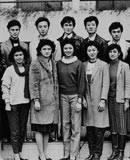不支持Flash
|
晒晒英语专业考研10大院校真题之北师大题(2)
III. Reading skills. (45)
Text 2
In real life, a snatch of dialogue (How are you?, Fine, thanks) takes place so quickly that it is easy to forget the complexity of the neurological planning and execution involved in the process. Any model of the production and comprehension of language - whether spoken, written, or signed -involves several steps, each of which must have some kind of neural representation. Neurological models of language attempt to delineate what these steps are and how they interrelate.
In speech production, for example, an initial intention to communicate is followed (or perhaps accompanied) by some kind of conceptualization of the message. There has also to be a point at which this conceptualization is encoded into the semantic and syntactic structure of the language used by the speaker (though it is not clear how far this stage can be separated from the preceding one). If the structure is to be spoken, it must be given some sort of phonological representation (e.g. as syllables, phonemes, or distinctive features). A motor-control programme must then be used to coordinate the multiplicity of Signals that have to be sent to the appropriate muscles controlling the different parts of the vocal tract. While this activity takes place, it is being constantly self-monitored: feedback is being received from the ear, from the sense of touch, and from the internal sensations generated by the movement of parts of the body. Other kinds of internal monitoring, at 'higher' levels, may also take place. An analogous sequence of events would be involved if the structure were to be written or signed.
The nature of neurolinguistic programmes has attracted a great deal of research in recent years, especially in relation to speech production. It is evident, for example, that the brain does not issue motor commands one segment at a time. A word such as soup is not neurologically transmitted as three separate steps - [s] + [u] + [p]. The articulation of [s] is lip-rounded, under the influence of the following vowel, which shows that the brain must be 'scanning ahead' while issuing commands for particular segments (coarticulation). When we consider the whole range of factors that affect the timing of speech events (such as breathing rate, the movement and coordination of the articulators, the onset of vocal-fold vibration, the location of stress, and the placement and duration of pauses), it is evident that a highly sophisticated control system must be employed, otherwise speech would degenerate into an erratic, disorganized set of noises. It is now recognized that many areas of the brain are involved: in particular, the cerebellum and thalamus are known to assist the cortex in exercising this control. But it is not yet possible to construct a detailed model of neurolinguistic operation that takes all speech-production variables into account.
Complete the following tasks.
60. Identify the text genre and register.
61. Draw up "a neurological model of speech production" based on the text.
特别说明:由于各方面情况的不断调整与变化,新浪网所提供的所有考试信息仅供参考,敬请考生以权威部门公布的正式信息为准。





